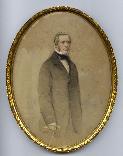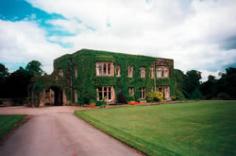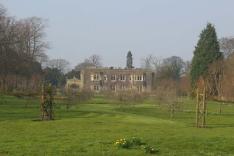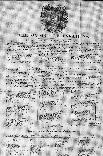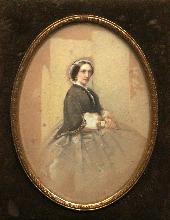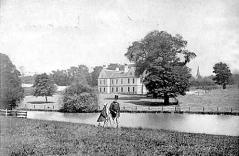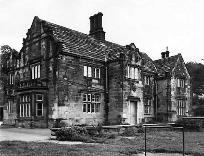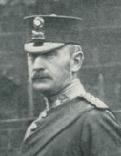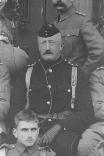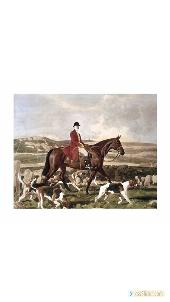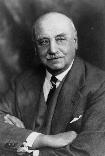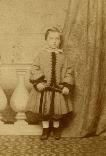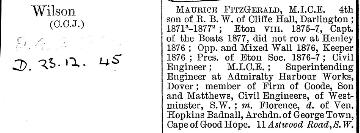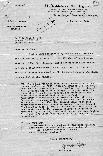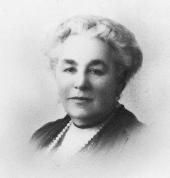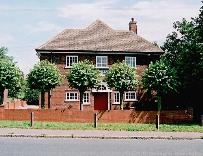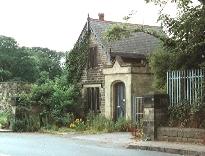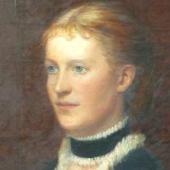See also
- Martha BASSETT's parents: Richard BASSETT (1744-1805) and Martha ARMITAGE ( - )
- Martha BASSETT's siblings: Henry BASSETT (1778-1852), Harriet BASSETT (1781-1785), Louisa BASSETT (1787-1796) and Richard BASSETT ( -1792)
Martha BASSETT (1776-1869)
1. Martha BASSETT, daughter of Richard BASSETT of Glentworth (1744-1805) and Martha ARMITAGE ( - ), was born in 1776 in Glentworth. She was baptised on 27 September 1776. She married John WILSON on 17 October 1798. She died on 18 February 1869.
John WILSON, son of John WILSON (bap.1730, d.1821) and Sarah LUCAS ( -1817), was born on 24 February 1767. He appeared in the census. He and Martha BASSETT had the following children:
| +2 | |
| +3 | |
| +4 |
Second Generation
2. Richard Bassett WILSON, son of John WILSON and Martha BASSETT, was born on 3 April 1806. He was a Magistrate and Landed Proprietor. He married Anne FITZGERALD on 5 December 1839. He died on 18 February 1867.
...of Cliffe Hall, Darlington, N.Yorks. The 1851 census lists him as a "Magistrate and Landed Proprietor occupying 60 acres of land employing 12 outdoor labourers and their wives. In the house at the time was a French governess aged 43 and ten servants. In 1861 there were again ten servants and a governess, but also two gardeners, a dressmaker, and a couple more staff.
Note on Cliffe Church, and its connection with the Wilson family:
Cliffe Church, which is dedicated to All Saints, is of unknown foundation, but probably dates from Saxon times. The style of the present edifice is Early English. The fabric was thoroughly restored in 1855, when a "Priest's door," a piece of Norman work, was preserved on account of its antiquity. The tower is massive, and contains three bells, each of which bears the date 1664. The clock was presented by Mrs. Wilson, of Sea Croft Hall in 1841, and the east window, representing the four Evangelists, by Miss Sarah Wilson. There are also two stained glass windows in the south aisle to the memory of Richard Bassett Wilson, of Cliffe Hall, and Anne, his widow. The latter, representing the Raising of Jairus' Daughter, is a beautiful piece of work by Meyer, of London and Munich. There are some other stained glass memorials, and also several tablets to the Witham family, former lords of the manor, who were seated at Cliffe Hall from the middle of the 16th to the early part of the present century, when the estate was sold to the late John Wilson, Esq., grandfather of the present Colonel J. G. Wilson, The roof of the nave is open, with four clerestory windows on each side. The pulpit and font, both of white stone, were the work of Mr. Priestman, of Darlington, and a handsome, carved oaken screen and reredos, erected, in 1876, by Colonel Wilson [Richard Murrough Wilson], were executed by Henry Harwood, of Manfield. The lectern, also of oak, was the gift of Miss Yeoman, In the churchyard are several old tombstones, supposed to belong to the 13th and 14th centuries.
Manfleld School A Glimpse into the Past,..
In the 1850's school building was taking place all over England and Wales. In the countryside the schools were predominantly Anglican, in the towns Methodist and to a lesser extent Roman Catholic, The reasons for this were varied. There was a genuine belief in the value of education and a humane impulse to better the lot of everyone.
In addition Victorian industry and farming had a diminishing need for child Labour. Children - urchins are what they were called - were becoming a nuisance, especially in the towns. Schools had a custodial as well as educational purpose, which in part accounts for their church like architecture with high windows. Manfield is no exception to this development.
In 1858 Richard Bassett Wilson, the then owner of Cliffe Hall and Estate gave one rood, two perches of land and an endowment for building Manfield Church of England School. It was at the same time that the Church was restored. The new building replaced a Dame's School, which stood on the site of what is now Four Oaks.
Its purpose or "Mission Statement' was clear. It was ' for the education of children and adults, or children only of the labouring, manufacturing and other poor classes in the Parish of Manfield.' This meant the education given was to be elementary, the 3 R's, reading/writing, 'rithmetic and religion. Children from better off backgrounds would attend Grammar Schools where Latin and Greek were pursued if not taught - Richmond, Kirby Hill ("closed before the First World War) Polam Hall and the Darlington Grammar Schools were the nearest.
The Minister or his Curate was to be in charge of the school, supported by a body of Church Wardens who were to ntribute 20 shillings a year to the upkeep of the school. When funding members resigned or died they could be replaced by others who were qualified by membership of the Anglican Church and subscription of at least 10 shillings a year, which bought one vote. Up to a maximum of six votes could be purchased for a donation of three pounds.
There is nothing in the original trust deeds about the qualifications of the teachers apart from the headlined fact that ' the Master or Mistress must be a member of the Church of England' The grounds for sacking a teacher were clear - 'defective or unsound instruction of the children in religion' The emphasis on the religious worthiness of the teacher was, in part, due to the ferment in the Victorian Church. Charles Darwin was to publish ' The Origin of Species' in 1859. The ideas it contained about species evolving over tens of millions of years had been common for at least thirty years - there was great interest in fossil collecting, an activity undertaken by scholarly gentlemen. The view that man shared a common line of ancestry with the apes challenged orthodox religious teaching which one instance dogmatically asserted that the world had been created in 4004 BC. It is doubtful whether these debates reached Manfield and if they did it is a near certainty that they were not mentioned in the village school. Of more interest is a photograph from 1883 showing Miss Sophie Haines aged 23 with 30 school children. Those identified are Harry, Esther and Mary Boyd, the generation of the great grandparents and grandparents to Mrs. Graveney's family. There is also Mary Gowton and Jack Tweddle. Others have not been identified but no doubt have descendants living In the area.
Children left school early in those days. In 1870 school was compulsory till 12. In 1902 the leaving age was raised to 13, in 1918 to 14. In 1944 the age went up to 15 and in 1973 to 16. Several villagers still remember the endless school gardening they were given to do when there was little for older pupils to do, especially in the post war years when books were in short supply.
In the mid 1950's the school ceased to be an all age elementary school.
Those who passed the eleven plus or 'scholarship' transferred to Richmond Girls High School or Boys' Grammar School or to the Richmond Secondary Modern - now combined as the Richmondshire School and one of the highest achieving in the country.
Manfield Church of England School still educates children aged 5 - 11 in a Christian ethos and has been praised in OFSTED and other reports for the all round achievement of its pupils.
When the school opened the telephone had been invented, but was not in use, there was no electricity, the car was at least thirty years away, the modern bicycle did not exist and manpower meant just that - a lifetime of heavy physical work in farms or in factories for men, and for women, long hours in domestic service or shops. In 2003, 145 years since Manfield School was founded a pupil at eleven is not half way through his/her education as the effective leaving age is now 18 because of Sixth Form Education and Vocational Training Schemes.
From a History of Manfield:
.... the following years have been difficult to trace, therefore the next record found was that of 1751, when the village belonged to Lord Marmion, the owner of Tanfield. Then, just over a hundred years later, in 1857, Richard Basset Wilson became owner. In 1823, when Edward Bains published his History Directory an Gazeteer of the county of York, he had this to say about Manfield: Manfield, in the wapentake of Gilling East, and liberty of Richmondshire: 9 miles north of Richmond; a parochial village; the church is an ancient structure with a tower steeple, and is dedicated to St Michael. The living is a rectory, in the patronage of the King. Here is a small free school, with an endowment of 10l. per annum. Population 440.
Cambridge University Alumni
Richard Bassett Wilson
Entered: Oct. 22, 1824
Died: 23 Mar 1867
More Information: M.A. 1833, incorp. from Oxford. [Eldest s. of John, Esq., of Seacroft Hall and Cliffe Hall, Yorks. (and Isabella, dau. of Richard Bassett). B. Apr. 3, 1806.] Matric. from University College, Oxford, Oct. 22, 1824, age 18; B.A. (Oxford) 1829; M.A. (Oxford) 1833. Adm. at Lincoln's Inn, 1829. Of Cliffe Hall, Yorks. Married, Dec. 5, 1839, Anne, dau. of William Fitzgerald, Esq., of Adelphi, Co. Clare, and had issue. Died Mar. 23, 1867. Brother of John (1825). (Al. Oxon.; Inns of Court; Burke, L.G., which gives Feb. 18 for date of death; G. Mag., 1867, I. 683.).
He studied at University College, Oxford and then at Lincoln's Inn for the law. The 1851 census lists him as a "Magistrate and Landed Proprieter occupying 60 acres of land employing 12 outdoor labourers and their wives. In the house at the time was a French governess aged 43 and ten servants. In 1861 there were again ten servants and a governess, but also two gardeners, a dressmaker, and a couple more staff". He performed the duties of a typical man of the gentry, including endowing a local school and helping the poor. There are two stained glass windows in the local Manfield Church dedicated to the memory of Wilson and his wife.
Anne FITZGERALD, daughter of William H.W. FITZGERALD (1789-1872) and Juliana Cecilia FITZGERALD ( - ), was born. She appeared in the census. She died on 11 July 1877. She and Richard Bassett WILSON had the following children:
| +5 | |
| +6 | |
| +7 | |
| +8 | |
| +9 | |
| +10 | |
| +11 | |
| +12 |
3. John WILSON of Seacroft Hall, co. Yorks, son of John WILSON and Martha BASSETT, was born on 1 January 1808. He married Anna Maria Isabella MACLEOD on 13 April 1846. He died on 29 January 1891.
John Wilson was born in 1808 and died at Seacroft Hall on 29th January 1891. He was educated at Rugby School and Trinity College, Cambridge and went on to become a JP for the West Riding of Yorkshire and a Captain in the 2nd West Yorkshire Militia. The Seacroft estate was bought by John Wilson Snr, of Camp Hall, Water Lane (1731-1821).
Anna Maria Isabella MACLEOD, daughter of Roderick MACLEOD of Cadboll, co. Ross, MP ( -1903), died on 26 December 1903. She and John WILSON had the following children:
| +13 | |
| +14 | |
| +15 | |
| +16 | |
| +17 |
4. Jane Lydia WILSON, daughter of John WILSON and Martha BASSETT, was born in 1815 (estimated). She married William SPOONER on 6 October 1841 in Whitkirk, Co. York. She died on 17 August 1898 in 8 Norham Gardens, Oxford.
William SPOONER of Walton Lodge, nr. Stafford, JP, son of Venerable William SPOONER (1778-1857) and Anna Maria Sydney O'BRIEN ( -1846), was born on 18 July 1811. He was a Barrister-at-Law, Judge of County Court for N. Staffs. He died on 19 May 1880. He and Jane Lydia WILSON had the following children:
| +18 | |
| +19 | |
| +20 | |
| +21 | |
| +22 | |
| +23 | |
| +24 |
Third Generation
5. Juliana Cecilia WILSON, daughter of Richard Bassett WILSON and Anne FITZGERALD, was born on 11 September 1840. She married Thomas Charles Johnson SOWERBY on 14 September 1865. She died on 15 November 1898.
In the year after her husband's death, the family were staying in Cornwall at her sister Augusta Bolitho's house, along with her sister Mary Lucia and a butler, footman, cook, lady's maid, three servants, two housemaids and a scullery maid. This according to the 1891 census. No children of the Bolitho's were listed, and it is not known if they had any.
Thomas Charles Johnson SOWERBY of Snow Hall, Darlington, Yorks, JP was born on 7 August 1838 in Ketton, Rutland. He died on 15 November 1890. He and Juliana Cecilia WILSON had the following children:
| 25 | Charles Fitzgerald SOWERBY (1866-1916). Charles was born on 31 July 1866. He was a Captain in the Royal Navy. He died on 31 May 1916 in Battle of Jutland. |
| 26 | Mabel Frances SOWERBY (c. 1868- ). Mabel was born circa 1868 in Gainford, Co. Durham. |
| 27 | Edith Mary SOWERBY (c. 1870- ). Edith was born circa 1870. |
| 28 | William Bassett SOWERBY (1870- ). William was born on 13 April 1870. He was a Colliery Company Assistant Secretary (1891). He married Lena HUNTER on 13 April 1900. |
| 29 | Edward Chaytor Sowerby SOWERBY (1872- ). Edward was born on 2 September 1872. |
| 30 | Mary Gertrude SOWERBY (c. 1882- ). Mary was born circa 1882. |
| 31 | Gerald SOWERBY ( -1913). Gerald died on 6 November 1913. |
6. John Gerald WILSON CB, son of Richard Bassett WILSON and Anne FITZGERALD, was born on 29 December 1841 in Yorkshire, Man[s]field. He was a Colonel in the Army. He married Angelina Rosa Geraldine O'BRIEN on 4 June 1873. He died on 8 March 1902.
John Gerald Wilson of Cliffe was Colonel, 3rd Battalion, York and Lancaster Regiment.
"Wilson. - Col. John Gerald Wilson, C.B., commanding 3rd Batt. York and Lancaster Regt., died March 8th, 1902, of wounds received in action between Tweebosch and Palmietkuil the previous day. He was the eldest son of the late Richard Bassett Wilson, Esq., of Cliffe, by his marriage with Anne, daughter of the late William Fitzgerald, Esq., of Adelphi, co. Clare. Col. Wilson was born in 1841, and educated at Cheltenham. He joined the 84th Regt. in 1858 from the Royal Military College as an ensign. After the death of his father in 1867, and his succession to the family estate of Cliffe Hall, Piercebridge, Darlington, he retired from the army as a capt., but subsequently accepted a commission in the volunteer force, and in 1873 was appointed to the command of the 1st North Yorkshire Rifle Volunteers. From the latter he was transferred in 1883 to the command of the 3rd West Yorkshire Militia, now the 3rd Batt. York and Lancaster Regt., and in 1889 he was appointed to the command of the West Yorkshire Volunteer Brigade. He was awarded the C.B. on the occasion of the Diamond Jubilee of Her late Majesty Queen Victoria in 1897, and was hon. col. of the 2nd Volunteer Batt. Prince of Wales’s West Yorkshire Regt. His battalion was first embodied in Dec., 1899, being disembodied after twelve months?service. It was again embodied in Dec., 1901, and volunteering for active service proceeded to South Africa. In the course of the war, Col. Wilson lost a brother (Col. Richard B. Wilson) and a son (2nd Lieut. Richard B. Wilson). The name of Col. J. G. Wilson is inscribed on the Eleanor Cross War Memorial erected at Cheltenham College."
His service record from the eighty-fourth regiment:
"Wilson, John Gerald, C.B.-Born at Cliffe Hall, Darlington, December 29th, 1841. From R.M.C. to Ensign 84th Foot without purchase December 31st, 1858; Lieutenant by purchase December 19th, 1862; Captain by purchase December 4th, 1866; Retired by sale of his Commission September 13th 1867; Lieutenant-Colonel 1st North York Rifle Volunteers June 9th, 1871; Resigned January, 1883; Lieutenant-Colonel 3rd Battalion York and Lancaster Regiment January 20th, 1883. Went with the 3rd Battalion to the South African War in 1901, and died of wounds received in action on March 2nd, 1902, while with Lord Methuen's column between Tweebosch and Palmietkiul. Served in Malta April 3rd, 1865, to June 13th, 1866."
Extract from The Last Post - Roll of Officers who fell in South Africa 1899-1902 by Mildred G Dooner, published by Naval and Military Press.
ALDBROUGH is a township containing 1,807 acres and 400 inhabitants. The soil is fertile, and in a high state of cultivation. The gross estimated rental of the township is £2,685, and the rateable value, £2,421. Eleanor, dowager duchess of Northumberland, is lady of the manor, and the most extensive landowner;
Col,. J. G. Wilson, Cliffe Hall, owns 145 acres; Messrs. Hutchinson and Shipton, 22 acres; and Miss Spencely, six acres besides cottage property.
Angelina Rosa Geraldine O'BRIEN, daughter of Rev. the Hon. Henry O'BRIEN ( - ) and Unk UNK ( - ), was born circa 1852 in Ireland. She and John Gerald WILSON had the following children:
| 32 | Richard Bassett WILSON (1874-1900). Richard was born in 1874 in Yorkshire, Manfield. He was a Lieutenant, Imperial Yeomanry. He died on 26 July 1900. |
| 33 | Murrough John WILSON (1875- ). Murrough was born on 14 September 1875 in Yorkshire. He had the title 'DL for North Riding, Yorks'. He was a Lieutenant-Colonel in the Army, Unionist Member of Parliament for Richmond, Yorks. He married Sybil May MILBANK on 16 February 1904. |
| 34 | Harriet Anne Dorothy WILSON (1876- ). Harriet was born in 1876 in Yorkshire. She married Frederick Richard MILBANK on 12 July 1904. |
| 35 | Denis Daly WILSON (1878- ). Denis was born on 22 October 1878. He married Mary Henrietta FRANKS on 17 December 1911. |
| 36 | Gladys Mary WILSON (1880- ). Gladys was born in 1880 in Yorkshire. She married John Beaumont HOTHAM on 15 August 1905. |
| 37 | Frank O'Brien WILSON (1883-1962). Frank was born on 30 April 1883 in France. He married Elizabeth Frances PEASE on 25 November 1919 in Middleton Tyas. He died on 7 April 1962 in Kilima Kiu, Kenya. |
| 38 | Gerald Geoffry WILSON (1884-1896). Gerald was born in 1884 in France. He died in December 1896. |
| 39 | Geraldine WILSON (1888- ). Geraldine was born in 1888 in Yorkshire. |
7. William Henry FITZGERALD-WILSON, son of Richard Bassett WILSON and Anne FITZGERALD, was born on 22 April 1844. He was a Barrister. He married Isabella Olave STANHOPE on 21 November 1885. He died on 17 April 1932.
(Adelphi, Corofin, co. Clare).
Isabella Olave STANHOPE, daughter of Russell Charles STANHOPE of Parsonstown Manor, co. Meath ( - ) and Ellinor Avena BLACKBURNE ( - ), was born in March 1861. She died on 28 November 1941. She and William Henry FITZGERALD-WILSON had the following children:
| 40 | Francis William FITZGERALD-WILSON (1886-1963). Francis was born on 8 December 1886. He was a Soldier. He married Phyllis Lockhart GREENSHIELDS in 1922. He died on 4 July 1963. |
| 41 | Olave Clare FITZGERALD-WILSON (1888-1912). Olave was born on 11 February 1888. She died in 1912. |
8. Mary Lucia WILSON, daughter of Richard Bassett WILSON and Anne FITZGERALD, was born in 1844 (estimated) in Kilnarsola, Co. Clare, Ireland. She died on 20 January 1930.
It is likely that she never married. She had not married by 1891, which was her 48th year. In fact, according to the 1901 census, she was living, aged 57, with her brother Maurice.
9. Colonel Richard Bassett WILSON, son of Richard Bassett WILSON and Anne FITZGERALD, was born in 1846 in Cliffe Hall, Piercebridge. He was a Colonel in the Army. He died on 21 March 1901.
Born in 1846 at Cliffe Hall, Piercebridge, he was educated at Rugby and University College, Oxford. He joined 3 (Militia) DLI in 1870 and rose to Honorary Colonel in 1893. He took his battalion to South Africa in January 1900 and was Mentioned in Despatches in February 1901. He died of enteric fever and pnuemonia at Kroonstad, on 21 March 1901. He was made a Companion of the Order of St. Michael and St. George for his service in the Boer War. Richard Wilson's brother and nephew also died in the Boer War of wounds received in action.
These medals are located in Medal Case 29, Display Group 39:
Order: St Michael & St George
Queen's South Africa (1899-02)
"War Office, March 4 1902.
MEMORANDUM
IMPERIAL YEOMANRY.
The undermentioned Officers resign their commissions and receive new commissions subject to the provisions of the Militia and Yeomanry Act, 1901, each retaining his present rank and seniority, viz.:-
(...) Yorkshire Hussars (Princess of Wales's Own). (...) Lieut.H.B.de la P.Beresford-Peirse, D.S.O."
A couple weeks later, on Friday, March 14th, he attended "a service (...) held (...) at Manfield Church, near Darlington, in memory of Colonel J.G.Wilson, C.B., of Cliffe-hall, who was killed at Klip Drift. (...) The lych-gates at the entrance to the churchyard were erected last June by public suscription in memory of Colonel Wilson's son, who also died in South Africa".
The latter, Lieutenant Richard Bassett Wilson, had died at Rustenburg on July 26th, 1900, of wounds received in action five days previously at Oliphant’s Nek - he was an officer of the Yorkshire Hussars.
It is to be noted that an unofficial tribute medal was awarded by the "Committee of the Yorkshire Volunteer Equiptment & Emergency Fund" to all members of the 3rd battalion (Yorkshire) Imperial Yeomanry "in recognition of their patriotism and the good service rendered by them in South Africa".
Hart's Annual Army List:
Richard Bassett Wilson, 3rd Battalion Durham Light Infantry (1st Durham Militia)
2nd Lieut or Ensign 18th July 1865
Lieut 8th April 1870
Captain 4th July 1874
Appointed to Reserve 7th July 1880
Born in 1846 at Cliffe Hall, Piercebridge, he was educated at Rugby and University College, Oxford. He joined 3 (Militia) DLI in 1870 and rose to Honorary Colonel in 1893. He took his battalion to South Africa in January 1900 and was Mentioned in Despatches in February 1901. He died of enteric fever and pnuemonia at Kroonstad, on 21 March 1901. He was made a Companion of the Order of St. Michael and St. George for his service in the Boer War. Richard Wilson's brother and nephew also died in the Boer War of wounds received in action.
10. Augusta Jane WILSON, daughter of Richard Bassett WILSON and Anne FITZGERALD, was born on 28 May 1848. She married Thomas Robins BOLITHO on 30 June 1870 in Westminster.
Thomas Robins BOLITHO was born on 13 September 1840. He had the title 'JP for Cornwall, DL'. He was a Director of Barclays Bank (following the absoption of Bolitho's - the family bank - in 1905. He died on 28 September 1925.
11. Emily Gertrude WILSON, daughter of Richard Bassett WILSON and Anne FITZGERALD, was born after 1851. She married James Fitzgerald BANNATYNE on 17 December 1878. She died on 10 October 1928.
The only clue as to the identity of this woman was through an internet search which revealed "Palk manuscripts in the possession of Mrs. Bannatyne of Haldon, Devon" by Emily Gertrude Wilson Bannatyne...
( London: H.M.S.O (1922) 492p. [Palk, Robert. Sir, Indian army officer: Manuscripts. 1769- 1786.]).
James Fitzgerald BANNATYNE, son of James BANNATYNE (c. 1800- ) and Harriet FITZGERALD ( - ), was born in 1835. He died on 18 October 1915. He and Emily Gertrude WILSON had the following children:
| 42 | Mary Stuart BANNATYNE (1881- ). Mary was born on 1 May 1881. She married Ludovic HEATHCOAT-AMORY on 12 July 1911. |
| 43 | James Fitzgerald BANNATYNE (1883-1916). James was born on 25 November 1883 in Ireland. He died on 14 May 1916, a casualty of the war. |
| 44 | Victoria Vera BANNATYNE (1887- ). Victoria was born on 11 September 1887 in Ivychurch, Yorkshire, England. |
12. Maurice Fitzgerald WILSON, son of Richard Bassett WILSON and Anne FITZGERALD, was born on 4 February 1858 in London. He was a Civil Engineer. He was confirmed on 20 October 1874. He married Florence May BADNALL on 2 August 1884. He died on 23 December 1945. He was buried in December 1945.
Maurice Fitzgerald Wilson was born on the 4th February, 1858, and died on the 23rd December, 1945. He was educated at Eton and at the Crystal Palace School of Engineering, and, after a short period at the Thames Ironworks, was articled in 1881 to Sir John Coode, K.C.M.G., Past-President Ins. S.E., spending most of his pupilage on the harbour works at Table Bay and Port Elizabeth. From 1883 to 1886 he was engaged on constructional work at Tilbury Docks for Messrs. Kirk and Randall and Messrs. Lucas and Aird, for whom he also worked on the Bodmin and Wadebridge Railway. In 1888 he was appointed resident engineer on the construction of the breakwater at St. Ives, Cornwall. From 1892 to 1895 he was resident engineer on the dock works of the London and South western Railway at Southampton. In 1896 he was appointed superintending engineer in charge of the survey for the Admiralty harbour, Dover, and later for the construction of the works, on which he was engaged until 1905. In 1906 he joined the firm of Coode, Son and Matthews, of which in 1924, on the death of Sir Maurice Fitzmaurice, Past-President Inst. C.E., he became senior partner. For nearly forty years he was engaged in the design and construction of harbours, docks, sea defence works, bridges and barrages, including dock extnesions for the Mersey Docks and Harbour Board; the Admiralty harbour of refuge at Peterhead; Fishguard harbour; the Lyttelton and gisbourne harbours, New Zealand; wharves and docks at Singapore; the Jahore causeway; Colombo harbour; entrance works and wharves at Lagos; harbour works on the Gold Coast, in Sierra Leone, and in Gambia; and work for the Whangpoo Conservancy Board, Shanghai. In 1921 he was appointed a member of the consultative committee of engineers of the European Commission for the Danube. From 1929 to 1933 he was in charge of the technical investigation of the proposed Severn barrage, upon which the report issued in 1933 was based.
Mr. Wilson was elected an Associate Member of the Institution on the 5th February, 1884, and was transferred to the class of Member onthe 12th February, 1895. He was elected to the Council in November 1928 and became Vice-President in November 1937, but declined nomination for election as President in November 1940 owing to ill health. In the previous February he had been elected an Honorary Member of the Institution. In 1919 he presented a Paper on the Admiralty Harbour, Dover, for which he was awarded the George Stephenson Gold Medal and a Telford premium. He was a member of the Sea Action Committee and later acted as its Chairman. For many years he took a leading part in the work of the British Standards Institution, of which he was Chairman from 1922 to 1933, and honorary life chairman of its Engineering Divisional Council.
In 1884 he married Florence May, daughter of the Venerable Hopkins Badnall, Archdeacon of the Cape, and had two sons. Mrs. Wilson died in 1941.
Obituary, published in the Journal of Institution of Civil Engineers, vol. 26, 1945-6.
Letter written to Maurice's son Fiennes' "Brass Hat" - a reference to his son's promotion within the Royal Navy? An image of the original letter is viewable as a Multimedia Object.
My dear Brass Hat,
Though you have been well known to me by name and reputation for some years I have never yet been brought into intimate relations with you so that in writing to offer you my congratulations I feel I should introduce myself lest you might think me presumptious. I understand you are now to adorn the head (of diminishing thatch?) of my son, up till this morning at 0000? hours a Lieutenant Commander R.N. and he, being as I have just said, my son, I introduce myself to you as his father. This will be clear and no doubt satisfactory. I feel it is a matter on which I may offer natural?? congratulations both to yourself and my son. To yourself fu?, though you will seldom have but? what I must describe as a birds eye view of him, you will I am sure be always comfortable and fairly well treated except upon the comparatively rare occasions when you may perchance be used as a water bucket or a football. At any rate I am sure you never be inconvenienced or pressed by any undue swelling of the temples. I am sure you will always be treated with consideration though you must not expect to be wrapped up in cotton wool. You will be carried high and will be naturally looked up to, provided this does not develope [sic] a squint. Nest?? in any case you may be sure the intention will be there.
My son I think must also receive my heartiest congratulations on having become your possessor. It is a prize he has long looked forward to with hopes of obtaining and I need not tell you with what pride and pleasure his mother and I saw? and I may call the announcement of your marriage in the papers this morning. This letter is therefore to wish you every success in your future journeyings together.
Please therefore accept these wishes yourself and convey them to Commander Wilson from his very loving
Father.
Maurice was at Eton College from 1871-1877. Whilst there he was awarded an enormous engraved pewter tankard for being "second in junior pulling"[!!]
Maurice Fitzgerald reached the top of his profession of civil engineering. His work included the building of the harbour at St. Ives in Cornwall, where there is a plaque. The details of his distinguished career are given in his obituary - printed below. Maurice's grandson Peter entered the same firm two generations later, where he spent his entire career, ending up as Managing Director, when the firm of Coode and Partners ceased to be a partnership.
Maurice was invited to become President of the Institute of Civil Engineers, but declined for family reasons. The correspondence about this is documented here.
Florence May BADNALL, daughter of The Venerable Hopkins BADNALL (1821-1892) and Sarah Elizabeth OWEN-SMITH (1839-1903), was born on 8 February 1858 in Cawthorne, Yorks. She died on 31 January 1941. She was buried in February 1941. She and Maurice Fitzgerald WILSON had the following children:
| 45 | Maurice Fiennes Fitzgerald WILSON (1886-1975) (known as 'Fiennes'). Fiennes was born on 22 June 1886 in 2 Talbot Villas, Old Dover Road, Gravesend, Kent. He was a Naval Officer. He married Catherine Gladys MURRAY on 4 August 1914 in St Judes, Portsea, Portsmouth, England. He died on 16 February 1975 in Watlington, Oxon. He was buried in Putney Vale Cemetery. |
| 46 | Bassett Fitzgerald WILSON (1888-c. 1972). Bassett was born on 1 September 1888 in St. Ives, Cornwall. He was a Soldier, artist. He married Muriel Gertrude SAMUELSON on 24 April 1915. He was buried circa 1941. He died circa May 1972. |
13. Roderick John WILSON, son of John WILSON of Seacroft Hall, co. Yorks and Anna Maria Isabella MACLEOD, was born on 15 April 1847. He died on 3 June 1881.
14. Darcy Bruce WILSON, son of John WILSON of Seacroft Hall, co. Yorks and Anna Maria Isabella MACLEOD, was born on 17 June 1851 in Ledbury, Worcestershire. He died in 1936.
Memories of Seacroft as a Village 1926 –1947
By Alan Noble, Church Warden, St James’ Seacroft
This was first published in the ‘Seacroft Herald’, the Parish Magazine of Seacroft, by instalments from November 1997 to May 1998. It is reproduced here with the permission of the author.
Section 1
I was born at Leyfield Farm Aberford, May l924. My mother and father moved to Taylors Yard in 1926. My father was employed at Swarcliffe farm by Mr Presious, and the cottage in Taylors Yard was a tied house. I can remember being taken to Seacroft National School by my elder brother Harold. The Headmaster was Mr Hardy and my teacher I think was Miss Lancaster. Our nature walks were through Foxwood and down to Foundry Mill, to sketch the Old Water Wheel and the cottages alongside. Seacroft Green was the centre of everything that happened in the village, Gala Days, cricket matches Saturday and Sunday it was a hive of activity, with coach 1oads of people from Leeds coming into the country. s children we were never allowed to go under the ropes that were around the cricket pitch. To keep the grass down in the outfield, Mr Gibbon’s horse Tommy was the lawn mower. My school friends were Raymond Thomson, Arthur Lindley and Ken Maskill of which I have a photograph taken in the Blacksmiths shop dated 1933, with Mr Jim Gibbon as Blacksmith. I remember being off school and, with my mother, going to the wash house next to Miss Hardist’s house, and Squire Darcy Wilson, on a white horse and wearing a scarlet tunic saying to my mother that your child should not be eating an apple during the day. My mother (who was always known never to be short of an answer) said to him ‘How do you know as you are not married’. Little did he know that the apple came from his own orchard, from his Gardener’s wife Mrs Rounding.
Section 2
Winter and Christmas were very exciting in the 1930’s. I can remember the squire Darcy Wilson allowing the villagers into the grounds of Seacroft Hall, to skate on the lake when it was frozen over and children to sledge in the snow. We had so many shop windows to gape into, looking for decorations for the tree, chocolate watches, sugar mice, and candles for the little holders we clipped onto the tree. The shops, to mention a few, were Mrs Wilby’s on the Green, Mrs Shoesmith’s off the Church, and down the steps to Mrs Johnson’s living room, opposite our school yard. I spent many happy hours playing in the yard behind the Blacksmith’s shop, there was a selection of old cars, logs of wood, ducks, hens and a pond, and not to forget a Hansom Cab which the girls used to play in. Audrey Ward reminded me of the time she saw old Mr Gibbon searching amongst the sawdust for his thumb which he had just cut off with the circular saw! Christmas time was the time when the pig was killed, along with the chickens and geese, as they all had to be prepared a couple of days before the great day, as we didn’t have fridges and freezers. The smells of Seacroft I will never forget; the smell of a horseshoe being burnt onto a hoof; the smell of leather in Mr Hardisty’s saddlers shop; my mother boiling ham and chickens in the set pot, and baking Christmas cakes and making Christmas puddings. ‘Oh! I must not forget Fred Taylors midding behind his slaughter house.’ Around Christmas time my mother would take ten or twelve children to the ‘Theatre Royal’ to see the pantomime. We would walk to Crossgates to get a tram to Leeds, call at the market and get bags of oranges and sweets, then join the queue for the Gods. That was our annual treat, and my mother always left trays of sausages in gravy in the oven for when we all returned. ‘Just another of those smells.’
Section 3
Christmas over and all the trimmings away we had plenty of dark nights to play with our toys. I got a set of a dozen lead soldiers, my sister a set of paints and my younger brother most likely some building blocks. We only ever got one present each from our parents. In the village we had our share of wonderful people, they all seemed to talk and have time for us children. Quite a few of us would go into the Blacksmith’s shop and watch Don Shires shoeing horses and making rims for cart wheels, older boys would help him blow the bellows for the fire. We would also go to watch Walter Smith, in the joiners shop, making a coffin for some person that has just died and anyone giving cheek would land in the coffin! Old Tom Gibbon was the undertaker. He measured and made the arrangements for the funerals, and delivered the coffin to the house on his hand cart. Our local policeman was Bobby Brown who lived in the cottage [now the dentist’s] at the bottom of the Nookin. He would stand no nonsense, and would take troublemakers down a tree lined Cross Gates Lane to the station at Cross Gates. Many times he would give the offender a clip round the ear and they would never reach the Police station. He said it saved him writing out a report. I can remember going to watch Mr Hardisty in his saddlers shop. He had lovely white hair and a little beard and was such a nice gentleman who made such beautiful things out of his leather skins. He never shouted or told you to get out. To go and get your hair cut was another experience. Arthur Broughton, quite a character, would fill you full of stories and, half way through your haircut, would break off for his tea and sandwich. All the village news was reported to George Taylor who worked as a journalist for the Skyrack Express. Mrs Fanny Taylor, his mother, had a sweet shop in a row of cottage next to where Audrey Ward lives. Mrs Taylor always wore Victorian clothes and had a bun in her hair, as did Mrs Stringer who lived in Jenny & Kevin Eastwood’s cottage.
Section 4
Monday morning was a busy time in Taylors Yard. My elder brother Harold, would have to get up early to light the fire under the ‘Set Pot’ in our wash-house. The water boiling all the whites, mother rubbing hard soap into the water, and stirring with a stick. Putting the washing into a ‘Peggy Tub’ and using the Peggy stick to swish the clothes around. During school holidays my sister Lucy and myself would have to give mother a hand to turn the mangle, to squeeze the clothes dry. They were then hung out in the field behind the Slaughter House. Often my mother, being a farmer’s daughter, would give Fred Taylor [the butcher] a hand with an unruly beast, while he used the pole axe to kill it. I remember during a school holiday, taking my dad his mashings, whilst he was ploughing the field next to the Red Lion; there was a gate by the Turn Pike milestone, and my dad handed me his red spotted handkerchief full of mushrooms, for my mother to cook for his tea. Saturday was the day my elder brother took me to Cross Gates Picture House [as it was called], to see cowboy Tom Mix and laugh at the antics of Buster Keaton. Mrs Wilby, who had a shop on the Green, ran a club for people to save the fare for our, once a year, bus trip to the coast, usually Bridlington. T have a photo of myself and Eleanor Johnson sat on the wooden breaker at Brid. Taken about 1929. I can just remember Squire Darcy Wilson dying, the older children went to church and gathered round the Crypt to watch his coffin being placed in a vault. After his death everything changed in the village, and I remember the building of the Village Hall in his memory.
Section 5
Everyone in the village knew each other, any children giving cheek and their mothers and fathers would be informed straight away. Where we lived in Taylors Yard, the big house, [which later became the Post Office] was Mr Driff Taylor’s. Our house joined his, and next door to us lived Mr Jim, and Elsie Gibbon with Betty and Brian. In later years Brian made the house into a Hairdresser’s shop. Mr & Mrs Fred Taylor lived at the top of the row cottages, with Johnsons, Atack, Guest & Mrs Mitchell next to the water pump. Mr Tom Gibbon lived in a house on main road, and I can remember those pears hanging over fence, in Autumn, just asking to be picked. Down the village lived Corketts, Roundings, Stringers, Streets, Lumbs, Browns, Fred Isles, Turnpenny and Mr and Mrs Kitchen who had a joiners shop. We would walk over the fields to Roundhay Park, passing down Bailey’s Lane to see the Old Pigeon Cote, on our left hand side. On the right would be Pigeon Cote Farm, at which my brother’s friend lived, ‘Jack Hopwood’, as his dad worked on the farm: A full day would be spent at Roundhay Park, sailing our boats on the little lake. We would take a bottle of water a block of lemonade crystals to make our lemonade, and eat banana sandwiches. Mother would never worry about us. Another day out would be to walk down the village to the beck that ran out of Seacroft Hall. It was a smashing playground, tree lined steep woodland running down to where Moresdale Lane is now. Where the Inglewoods are now there was a rugby field. The older girls and boys would walk on what was called ‘The Duck Walk’ which went from the Town End to Killingbeck, trying to meet their intended. My mother used to collect for the Nurses Association in Crossgates, and I think for about one shilling [5p] a month. This was to pay for the District Nurse to come if a baby was due, or any illness in the family, as it cost 2/6d [12.5p] for a doctors visit, and people couldn’t afford so much.
Section 6
Every Thursday my mother would take my brother and myself along the Coal Road to visit her mother and father at Bay Horse Farm, Shadwell, of which my Grandad was tenant farmer under Lord Harewood. Grandma and Grandad had sixteen children, thirteen girls lived and one son. They had their own pew in Shadwell Church and were all very religious. Every evening one had read a passage of the Bible. Part of Grandad’s tenancy was when harvest was finished he had to cart so many loads of coal from Barnbow Pit to Harewood House. Hence "The Coal Road’. Passing in to York Road, he had a toll of 1/2d wheel to pay at the Toll House [which as a lot of people remember, is where Mrs Ibbotson (who is still around at 93 and often talks to me about my mother) lived]. I was told Darcy Wilson never charged more than 1/6d [7%p new money] a week for his cottages, but would never allow baths to be fitted in them. He is reputed to have said ‘I haven’t a fixed one in my Hall, so why should you! ’ When the Hall was auctioned and all the furniture arranged for sale there were quite a number of sit-up baths of all different sizes. My dad gave up farming and bought two shire horses with flat carts, to hire. He had contracts with the Council repair the roads. A council man would go with my dad, with a pile of tarmac and a couple of shovels and bumpers, to flatten the holes.
Section 7
Dad would dress up Peggy and Prince every Whitsun-tide, put forms [for seats] on the back of the flat carts and take the children of the Village Sunday Schools to Aberford, usually Leyfield Farm where I was born. What an honour it was to sit beside my dad! Dad would stable the two horses at Dixon’s farm which stood at what is now the entrance to the Hansby's. As you can imagine Seacroft had many farms Stocks Farm, Park Farm; ‘Laburnam Farm on the Green’; Park Farm [where the Lion and Lamb pub is]. Hawthorn, White Laithe and Providence which I think was ‘Carters’ at the point where the Ring Road and Coal Road now meet. As the estates of Crossgates, The Oval and Hawkhills started to be built everybody seemed to be milkmen. Dennis Osborne, Mr Lumb and Jim Gibbon - who was my first boss when I left school, seven days a week 7/6d a week. We had two daily deliveries, except Sundays, and I enjoyed every minute that I worked. I had always wanted to be a farmer, but my mother and father discouraged me, getting soaking wet and tied houses were not all it seemed. Jim Gibbon bought his milk from Mr Leake at Grimes ’ Dyke Farm where Sidney Webb worked [brother of Ronnie]. They were all such lovely people, as everyone that I knew in Seacroft were!
Section 8
We always had plenty of entertainment during summer. Shows, cricket matches, feasts and RoundhayTattoo, held every year or two. The cricket matches were always well supported, both home and away, as dozens of supporters would travel to Garforth, Micklefield and Kippax to cheer our team. Crossgates Feast held in the field where the old Regal Cinema [now Mayfair Bingo] was built. Chris Johnson, the owner, was a big fat man who sat on a chair at the entrance. Dad always supplied him with a giant Dahlia twice a week for his button hole and received 2/6d for his efforts. The Feast was powered by a gleaming steam engine called ‘Yorkshire Man’, made by Fowler’s of Leeds, and having a plaque with the words ’ Who’d have thought it’ on the side. Dad and Fred Taylor went to Scholes Show one Saturday afternoon in a pony and trap. Later that day the pony arrived home with Dad and Fred asleep in the trap. My mother, horrified at seeing Dad, put his head under the pump in comer of the yard. I never saw my Dad with drink after that. In 1935 we moved to Crossgates, but my sister Lucy brothers Harold and Dennis were always back in Seacroft to dance in the Village Hall. Mrs Kitchen taught me to dance, she was the wife of the local joiner and the life and soul of the village. Seacroft has always been a lovely place to live in. I have never been ashamed to admit that I have lived in it. I remember going into Leeds, passing down York Road, and seeing children with no shoes on and rows of houses so close together. When Darcy Wilson’s nephew sold all the land to the Council to build Seacroft Estate and provide new houses for all the people that lived in the streets I thought how wonderful for those children to be able to share our open fields and breath our beautiful fresh air. When I used to bring my Dad his tea, whilst ploughing the field next to the Red Lion at Whinmoor I would say to him ‘Why is it always windy up here’ his reply was that was why they call it Whinmoor or ‘Windy Moor’. ‘That’s all folks’ I’ve enjoyed every memory that has been written. Hope you have too.
Darcy Bruce Wilson M.A., Barrister at Law, JP, Captain Yorkshire Hussars, who died, unmarried, at Seacroft Hall in 1936. The estate was subsequently sold to Leeds Corporation and the Hall was demolished in 1953-4.
In 1891, according to the census, he was living at Seacroft Hall with his sister Louisa and six servants - a footman, cook, kitchenmaid and two housemaids.
In 1881, however, he was lodging in 1 East Chapel Street, Westminster, London, but was also practising as a Barrister.
"Warton parish; John Lucas's history of, Editor J. R. Ford & J. A. Fuller-Maitland 1931; review North Western Naturalist VI
(1931) 260. Manuscripts one time in library of D. B. Wilson, Seacroft Hall Leeds*."
Devon Record Office 48/14/144/4 23 November 1921
Contents:
Letter from D. B. Wilson to A. H. Wilson about the Seacroft Settled Estate [near Leeds].
With a memorandum on letter.
15. Arthur Henry WILSON, son of John WILSON of Seacroft Hall, co. Yorks and Anna Maria Isabella MACLEOD, was born on 24 April 1853. He married Alice Louisa WAINWRIGHT on 12 November 1885.
(Sandridge Park, Totnes).
Alice Louisa WAINWRIGHT was the daughter of George Drake WAINWRIGHT ( - ). She and Arthur Henry WILSON had the following children:
| 47 | Gladys Sabine Fyers WILSON (1886-1935). Gladys was born on 6 October 1886. She died on 1 May 1935. |
16. Constance WILSON, daughter of John WILSON of Seacroft Hall, co. Yorks and Anna Maria Isabella MACLEOD, died on 1 December 1938. She married Charles John Aylmer EADE.
Rev. Charles John Aylmer EADE was born on 11 October 1845. He was a Clergyman. He died on 28 November 1926. He and Constance WILSON had the following children:
| 48 | John EADE (1887-1968). John was born on 18 December 1887. He died on 9 August 1968. |
| 49 | Charles EADE (1890- ). Charles was born on 19 July 1890. He married Betty Annesley HOBBES on 23 August 1928. He married Honor Many MEYRICK on 25 September 1943. |
| 50 | Aylmer EADE (1902- ). Aylmer was born on 29 January 1902. |
17. Louisa WILSON, daughter of John WILSON of Seacroft Hall, co. Yorks and Anna Maria Isabella MACLEOD, was born circa 1862 in France. She died in 1948.
18. Rev. William Archibald SPOONER, son of William SPOONER of Walton Lodge, nr. Stafford, JP and Jane Lydia WILSON, married Frances Wycliffe GOODWIN.
Warden of New College Oxford 1903-24, Hon Fell 1925-30, formerly Lecturer, Tutor, and Public Examiner; born 22 July, 1844; educated Oswestry Gram. sch., and New College Oxford, (MA, DD).
Rev. William Archibald Spooner, D.D., Warden of New=
College, Oxford; born in London 22 July 1844, bapt.
privately, received into the church at Elmdon 12 January
1845 ; educated at Oswestry Grammar School and at New
College, Oxford, matriculated 18 October 1862, Scholar
1862-67, B.A. (ist-class in Moderations and in the Final
Classical Schools) 1867, Fellow 1867, M.A. 1869, U.D.
1903; Public Examiner in University of Oxford 1875-76,
1890-92 and 1899, Chaplain to the Archbishop of
Canterbury 1881-83, Hon. Canon of Christ Church,
O.xford, 1899, Examining Chaplain to the Bishop of
Peterborough 1901, Warden of New College, Oxford,
1903, ProA'ice Chancellor of O.xford University 1908
-1909; Author of "The Histories of Tacitus, with
Introduction and Notes," 1891, and "Bishop Butler, his
Life and Writings," 1901.
Frances Wycliffe GOODWIN was the daughter of Right Rev. Harvey GOODWIN DD, DCL, Bp Carlisle ( - ).
19. Mary Anne SPOONER, daughter of William SPOONER of Walton Lodge, nr. Stafford, JP and Jane Lydia WILSON, was born on 30 October 1842 in 17 Chapel Street, Belgrave Square, London. She was baptised in Elmdon.
20. the Venerable Henry Maxwell SPOONER, son of William SPOONER of Walton Lodge, nr. Stafford, JP and Jane Lydia WILSON, was born on 9 May 1846. He was an Archdeacon. He died on 1 April 1929. He married Catherine GOODWIN.
Fell of Magdalen College Oxford, Hon Canon of Canterbury Cathedral, ordained 1871, Domestic Chaplain to Archbishop Tait 1870-75, Vicar of Boughton-under-Blean, Kent 1875, and Holy Trinity, Maidstone 1887, Rector of Saltwood, Hythe, Kent 1893, Archdeacon of Maidstone 1900-21; born 9 May, 1846; educated Oxford U (MA); married 12 Oct 1875, Catherine, 2nd daughter of Rt Rev Harvey Goodwin, DD (see above), and died 1 April, 1929.
Ven*"'' Henry Ma.\wel! Spooner, bom at Elmdon 9 May, bapt
there 7 June 1846; educated at Oswestry Grammar School
and at Balliol College, Oxford, matriculated 4 April 1864,
Exhibitioner 1864-68, B.A. (ist-class Classical Moderations
1865, ist-class Lit. Hum.) 1868, M.A. 187 1, Fellow of Magdalen
College 1868-76, Lecturer 1868-70; Domestic Chaplain to the
Archbishop of Canterbury 1870-75, Vicar of Boughton-under-
Blean, co. Kent, 1875-87, and of Holy Trinity, Maidstone,
1887-93, Rector of Saltwood, co. Kent, 1893-1900, Hon. Canon
of Canterbury 1898-1900, Examining Chaplain to the Bishop
of Rochester 1891, and of Winchester 1895, Archdeacon of
Maidstone and Canon Residentiary of Canterbury 1900.
Catherine GOODWIN was born in 1848. She died in 1929. She and Henry Maxwell SPOONER had the following children:
| 51 | Catherine SPOONER (1880-1905). Catherine was born in 1880. She died in 1905. |
21. Janet Sarah SPOONER, daughter of William SPOONER of Walton Lodge, nr. Stafford, JP and Jane Lydia WILSON, married Henry SALT.
22. Catherine Barbara SPOONER was the daughter of William SPOONER of Walton Lodge, nr. Stafford, JP and Jane Lydia WILSON.
23. George Archibald SPOONER, son of William SPOONER of Walton Lodge, nr. Stafford, JP and Jane Lydia WILSON, was born on 11 July 1879. He died on 3 August 1879.
24. Barbara SPOONER, daughter of William SPOONER of Walton Lodge, nr. Stafford, JP and Jane Lydia WILSON, was born on 28 January 1881 in Keble Terrace, Oxford. She died on 29 January 1881.
